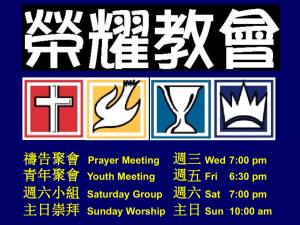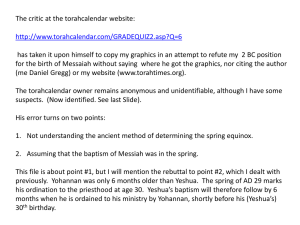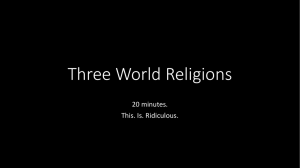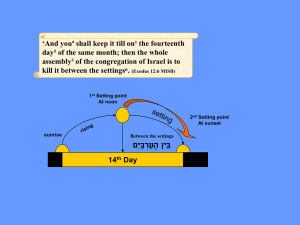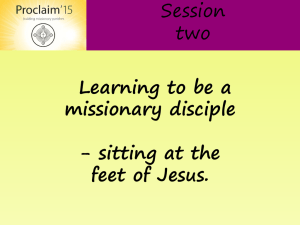Powerpoint Slides
advertisement
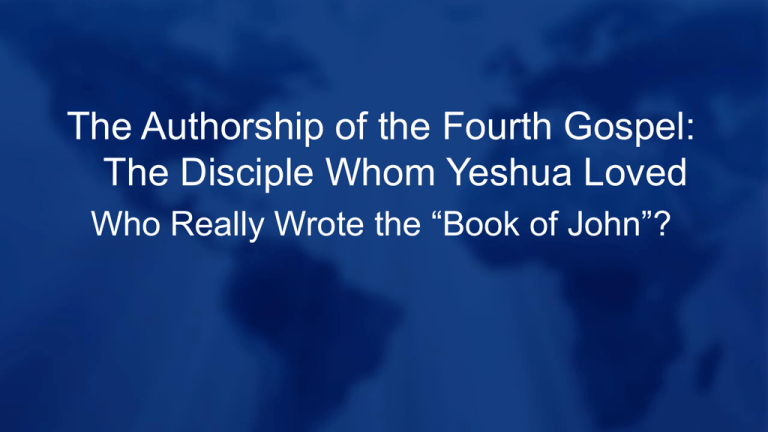
The Authorship of the Fourth Gospel: The Disciple Whom Yeshua Loved Who Really Wrote the “Book of John”? The Disciple Whom Yeshua Loved Kepha turned and saw that the disciple whom Yeshua loved was following them. (This was the one who had leaned back against Yeshua at the supper and had said, "Master, who is going to betray you?") When Kepha saw him, he asked, "Master, what about him?" Yeshua answered, "If I want him to remain alive until I return, what is that to you? You must follow me." (4th Gospel 21:20-24) The Disciple Whom Yeshua Loved Because of this, the rumor spread among the brothers that this disciple would not die. But Yeshua did not say that he would not die; he only said, "If I want him to remain alive until I return, what is that to you?" This is the disciple who testifies to these things and who wrote them down. We know that his testimony is true. (4th Gospel 21:20-24) Do We Base our Faith on Bible or Tradition? What does the Bible Say? Would You Believe the Bible Over Tradition if the Bible Clearly Says that someone other than John Wrote the 4th Gospel? “Prove all things; hold fast that which is good” (1Th. 5:21). “Study to shew thyself approved unto God, a workman that needeth not to be ashamed, rightly dividing the word of truth.” (2Ti. 2:15). Be a Berean! Now the Bereans were of more noble character than the Thessalonians, for they received the message with great eagerness and examined the Scriptures every day to see if what Paul said was true. Acts 17:11 Why Should We Doubt That Yochanan (John) Wrote the 4th Gospel Yochanan Wrote the Book of Revelation The revelation of Yeshua Messiah, which Elohim gave him to show his servants what must soon take place. He made it known by sending his angel to his servant Yochanan, who testifies to everything he saw-- that is, the word of Elohim and the testimony of Yeshua Messiah. (Revelation 1:1-2) Yochanan, To the seven assemblies in the province of Asia: Grace and peace to you from him who is, and who was, and who is to come, and from the seven spirits before his throne. (Revelation 1:4) Yochanan Wrote the Book of Revelation I, Yochanan, your brother and companion in the suffering and kingdom and patient endurance that are ours in Yeshua, was on the island of Patmos because of the word of Elohim and the testimony of Yeshua. (Revelation 1:9) I, Yochanan, am the one who heard and saw these things. And when I had heard and seen them, I fell down to worship at the feet of the angel who had been showing them to me. (Revelation 22:8) The first three gospels all mention these three notable events of Yeshua’ ministry: his raising of the daughter of Jairus (Mt. 9:18-26, Mk. 5:22-43, Lu. 8:41-56). his transfiguration (Mt. 17:1-9, Mk. 9:2-9, Lu. 9:28-36), his Gethsemane prayers (Mt. 26:36-46, Mk. 14:32-42, Lu. 22:39-46). Only three disciples were present at these events, and the Apostle John was one of them (Mt. 17:1 & 26:37, Mk. 5:37, 9:2 & 14:33, Lu. 8:51 & 9:28). Although John was an eyewitness to all of these events there is no mention of these key events in the gospel that today bears John’s name! After six days Yeshua took with him Kepha, Ya'acov and Yochanan the brother of Ya'acov, and led them up a high mountain by themselves. There he was transfigured before them. His face shone like the sun, and his clothes became as white as the light. (Matthew 17:1-2) Afterward, these three disciples were strictly commanded about how and when to proclaim his glory: As they were coming down the mountain, Yeshua instructed them, "Don't tell anyone what you have seen, until the Son of Man has been raised from the dead." (Matthew 17:9) It turns out every event where John is referred to by name in the first three gospels is missing from the fourth gospel! Yeshua told John, “ye know not what manner of spirit ye are of” when rebuking John and his brother after they sought to “command fire to come down from heaven” (Lu. 9:54-55). John and Peter were sent by Yeshua to prepare the Passover (Lu. 22:8). Yeshua “privately” answered the questions of John, Peter, James, and Andrew on the Mount of Olives (Mk. 13:3). The mother of John and his brother asked Yeshua to seat them, “one on thy right hand, and the other on thy left hand, in thy glory” (Mk. 10:35-41). We know many things about John: his name; he was a son of Zebedee and had a brother named James; he was a fisherman; he and his brother were partners with Peter and were present when Yeshua healed Peter’s wife’s mother; John was one of the twelve apostles chosen by Yeshua; he and his brother asked for the seats next to Yeshua and they were surnamed by Yeshua, “Boanerges, which is, The sons of thunder”; he and his brother once wanted to call fire down from heaven on a group of people and Yeshua rebuked them for it; John was the one who told Yeshua, “we saw one casting out devils in thy In the 4th Gospel we are informed that Peter and "another disciple" ran to the tomb and that the "other disciple, the one whom Yeshua loved" (see 4th Gospel 20:2) got there first. Then Peter arrived, went into the tomb and saw the grave clothes. Finally the other disciple, who had reached the tomb first, also went inside. He saw and believed (4th Gospel 20:8) Now the text goes out of its way not to say that Peter believed. But the "other disciple" - the one who is the author of this 4th Gospel - "saw and believed." Yet after that event, Yeshua appeared to the Eleven and rebuked them for not believing when the women told them he was raised: Later Yeshua appeared to the Eleven as they were eating; he rebuked them for their lack of faith and their stubborn refusal to believe those who had seen him after he had risen (Mark 16:14). What Do We Know About the “Disciple Whom Yeshua Loved”? Fourth gospel 13:21-28 (with Yeshua at the supper) Fourth gospel 18:12-18 (with Yeshua at his trial) Fourth gospel 19:25-27 (with Yeshua at the cross) Fourth gospel 20:1-10 (first man at Yeshua’s tomb & first to believe) Fourth gospel 21:2-24 (first to identify Yeshua & author of this gospel) He is at the supper Yeshua had with his disciples just before his betrayal. Yeshua had just washed his disciples feet and was revealing to them that one of them was going to betray him. His disciples stared at one another, at a loss to know which of them he meant. One of them, the disciple whom Yeshua loved, was reclining next to him. Shimon Kepha motioned to this disciple and said, "Ask him which one he means." Leaning back against Yeshua, he asked him, "Master, who is it?" (4th Gospel 13:22-25) Early on the first day of the week, while it was still dark, Miryam Magdalene went to the tomb and saw that the stone had been removed from the entrance. So she came running to Shimon Kepha and the other disciple, the one Yeshua loved, and said, "They have taken the Master out of the tomb, and we don't know where they have put him!" So Kepha and the other disciple started for the tomb. Both were running, but the other disciple outran Kepha and reached the tomb first. (4th Gospel 20:1-4) Shimon Kepha and another disciple were following Yeshua. Because this disciple was known to the high priest, he went with Yeshua into the high priest's courtyard, but Kepha had to wait outside at the door. The other disciple, who was known to the high priest, came back, spoke to the girl on duty there and brought Kepha in. (4th Gospel 18:15-16) Near the cross of Yeshua stood his mother, his mother's sister, Miryam the wife of Clopas, and Miryam Magdalene. When Yeshua saw his mother there, and the disciple whom he loved standing nearby, he said to his mother, "Dear woman, here is your son," and to the disciple, "Here is your mother." From that time on, this disciple took her into his home. (4th Gospel 19:25-27) The Disciple Whom Yeshua Loved Kepha turned and saw that the disciple whom Yeshua loved was following them. (This was the one who had leaned back against Yeshua at the supper and had said, "Master, who is going to betray you?") When Kepha saw him, he asked, "Master, what about him?" Yeshua answered, "If I want him to remain alive until I return, what is that to you? You must follow me." Because of this, the rumor spread among the brothers that this disciple would not die. But Yeshua did not say that he would not die; he only said, "If I want him to remain alive until I return, what is that to you?" This is the disciple who testifies to these things and who wrote them down. We know that his testimony is true. (4th Gospel 21:20-24) How Many People Do the Gospels Identify as Being Loved By Yeshua? Only 4! (2 Men) 1 in the First Three Gospels 3 in the 4th Gospel (only one of them was a man) Who is that man??? The Rich Young Ruler As Yeshua started on his way, a man ran up to him and fell on his knees before him. "Good teacher," he asked, "what must I do to inherit eternal life?" "Why do you call me good?" Yeshua answered. "No one is good-- except Elohim alone. You know the commandments: 'Do not murder, do not commit adultery, do not steal, do not give false testimony, do not defraud, honor your father and mother.'" "Teacher," he declared, "all these I have kept since I was a boy." Yeshua looked at him and loved him. "One thing you lack," he said. "Go, sell everything you have and give to the poor, and you will have treasure in heaven. Then come, follow me." At this the man's face fell. He went away sad, because he had great wealth. (Mark 10:17-22) Lazarus Now a man named El‛azar (Lazarus) was sick. He was from Bethany, the village of Miryam and her sister Martha. This Miryam, whose brother El‛azar now lay sick, was the same one who poured perfume on the Master and wiped his feet with her hair. So the sisters sent word to Yeshua, "Master, the one you love is sick." (4th Gospel 11:1-3) Lazarus His name comes from the Greek word La,zaroj, Lazarus, which corresponds to the Hebrew rz"[.l; [pronounced Lazar], apparently the same as rz"['l.a,, (El‛azar or more commonly Eleazar) which means "whom Elohim helps." This El‛azar is the one whom the writer of the 4th Gospel identifies by name as the one whom Yeshua loved! There is no other man mentioned in the 4th Gospel about whom is says that Yeshua loved him. Two verses later it says the same thing again: When he heard this, Yeshua said, "This sickness will not end in death. No, it is for Elohim's glory so that Elohim's Son may be glorified through it." Yeshua loved Martha and her sister and El‛azar. (4th Gospel 11:4-5) Why did he say it again? Is Yeshua’s love for El’azar germane to the story? As the story unfolds, Yeshua tells his disciples that they are headed back to Yehudah, to the town of Bethany to see their friend El‛azar: After he had said this, he went on to tell them, "Our friend El‛azar has fallen asleep; but I am going there to wake him up." (4th Gospel 11:11) “Friend” Greek o` fi,loj (ha philos) from phileo which means “to love.” A “friend” is “one who is loved.” This is now the third time Yeshua refers to El’azar as one who is loved by him. Read 11:11-34 Yeshua wept. Then the Yehudim said, "See how he loved him!" (11:35-36) This is an amazing statement. Some translations render this, "Behold, how he loved him." To paraphrase, the text is saying that the Jews even took note of Yeshua’s love for Lazarus. "Stop and take notice how much Yeshua loved El‛azar"! This is the 4th time Lazarus is identified as the one whom Yeshua loved! Therefore Yeshua no longer moved about publicly among the Yehudim. Instead he withdrew to a region near the desert, to a village called Ephraim, where he stayed with his disciples. Then, as the season of the Pesach was nearing, Yeshua and his disciples did return to Yehudah (Judea): Six days before the Pesach, Yeshua arrived at Bethany, where El‛azar lived, whom Yeshua had raised from the dead. Here a dinner was given in Yeshua's honor. Martha served, while El‛azar was among those reclining at the table with him. (12:1-2) Meanwhile a large crowd of Yehudim found out that Yeshua was there and came, not only because of him but also to see El‛azar, whom he had raised from the dead. So the chief priests made plans to kill El‛azar as well, for on account of him many of the Yehudim were going over to Yeshua and putting their faith in him. (12:9-11) The fame of El‛azar on account of his being raised from the dead was becoming widespread: Now the crowd that was with him when he called El‛azar from the tomb and raised him from the dead continued to spread the word. Many people, because they had heard that he had given this miraculous sign, went out to meet him. (12:17-18) The final mention of El‛azar by name is in 12:17 of the 4th Gospel. El‛azar appears in chapter 11 where he is the subject whom Yeshua raised from the dead and the one who is emphatically named as the "one whom Yeshua loved." His name is placed into the record of the 4th Gospel a total of 13 times in chapters 11 and 12. And then after chapter 12, he seems to disappear. Where did he go? What happened to him? After El‛azar, who was emphatically identified as being loved by Yeshua, seems to disappear from the narrative after chapter 12, one who is designated by the title "the disciple whom Yeshua loved" mysteriously appears out of nowhere in chapter 13 and finds himself imbedded into the narrative all the way to the end of the Gospel. Then, the writer's final commentary is to identify himself with this "disciple whom Yeshua loved." Let’s Revisit the Events which “the Disciple that Yeshua Loved” was involved with in light of the identification of Lazarus… First is the testimony of that "other disciple" outrunning Kepha. It says that he reached the empty tomb first, looked into the tomb and waited outside. Then Peter went in and saw the empty tomb. Finally, the "other disciple" went in and is credited in the narrative as having looked, that he "saw and believed." The testimony of Mark's gospel excludes the apostle John as being identified as this one who "saw and believed." Yeshua later scolded all eleven disciples for not believing: Later Yeshua appeared to the Eleven as they were eating; he rebuked them for their lack of faith and their stubborn refusal to believe those who had seen him after he had risen (Mark 16:14). So, John could not have been the disciple whom Yeshua loved. Why it is that this one "saw and believed"? Shimon Kepha and another disciple were following Yeshua. Because this disciple was known to the high priest, he went with Yeshua into the high priest's courtyard, but Kepha had to wait outside at the door. The other disciple, who was known to the high priest, came back, spoke to the girl on duty there and brought Kepha in. (4th Gospel 18:15-16). Kepha turned and saw that the disciple whom Yeshua loved was following them. (This was the one who had leaned back against Yeshua at the supper and had said, "Master, who is going to betray you?") When Kepha saw him, he asked, "Master, what about him?" Yeshua answered, "If I want him to remain alive until I return, what is that to you? You must follow me." (4th Gospel 21:20-24) Because of this, the rumor spread among the brothers that this disciple would not die. But Yeshua did not say that he would not die; he only said, "If I want him to remain alive until I return, what is that to you?" This is the disciple who testifies to these things and who wrote them down. We know that his testimony is true. (4th Gospel 21:20-24) Was the author of the 4th Gospel trying to hide his identity? How could millions of sincere believers for some 1900 years have been deceived about the identity of the writer of the 4th Gospel? What does this say about the reliability of tradition? Acknowledgment I must acknowledge where I came into this understanding of the real author of the 4th Gospel. Hats off to J. Phillips for his carefully thought out insights into the true understanding of its authorship. His book, entitled, The Disciple Whom Jesus Loved, can be read in its entirety at his website, www.TheDiscipleWhomJesusLoved.com.
